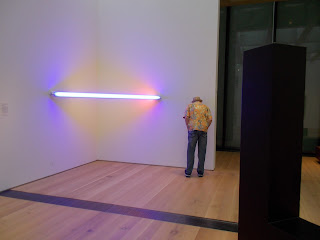DATE VISITED: 06/14/2015
SITE: St. Louis Art Museum
PERSONAL
REFLECTIONS:
I have to admit…I am not a very creative person and I’ve never
really been into art. When I was in Washington DC…twice, I went through only one
gallery and that’s because a friend wanted to go. So when Dirk mentioned the
art museum, I smiled on the outside and groaned loudly on the inside.
Never again. There was more than just art here. Sure, it had
pictures and sculptures, but it also had what I would consider artifacts…and
that interests me. To be fair, it wasn’t that I enjoyed the art that much more although
some was really interesting…no, it’s because the slant that Dirk gave the art.
He was renaming things, telling me what the person in the painting was thinking
and making me laugh the whole time.

 We had gone by the museum the previous day on our trolley tour
of St. Louis, so some of the external pictures of the museum are from that
sunny Saturday.
We had gone by the museum the previous day on our trolley tour
of St. Louis, so some of the external pictures of the museum are from that
sunny Saturday.
Founded in 1881 as the St. Louis School and Museum of Fine
Arts, the collection was housed in a building downtown. The current location and
structure was built for the 1904 World’s Fair, which was also known as the Louisiana
Purchase Exposition.
The building has the words “Dedicated to art and free to all” carved
on the front and in 1908, the first museum director arranged for a municipal
tax to support the museum.
The museum underwent two more name changes. In 1909, it was renamed
the City Art Museum and in 1972 it was renamed Saint Louis Art Museum, which it
is still called.
A planned expansion estimated to cost $125 million was put on
hold when the economy started tanking but thanks to private donations, the
expansion went on in 2009. The foundation was not only able to raise the $130
million needed for the expansion, but also an additional $31.2 million for
operating the larger facility.
At one point, we were walking thru an exhibit on rooms as they
existed during different times in US history. We heard an alarm and looked over
and saw a guy and girl coming out of an alcove. The guard nearby said the alarm
was set too close to the guard rail and people kept setting it off. So Dirk and
I walk in there and what’s the first thing I do? Point at something to get
Dirks attention…right over the guardrail…and the alarms go off.
“Oh hell” came out rather loudly and I turned around and
looked at the guard…he’s laughing. I told him, “You’d think after just watching
someone else do it, I wouldn’t be dumb enough to repeat it a minute later”. All
Dirk could do was shake his head.
I was delighted to find out that Dirk has some of the same disdain for
most modern art that I do. Calling some of this stuff art is laughable, but
what the heck, someone’s making money off it…just not from me.
 |
| Ok, how is a glowing stick a piece of art? |
 |
| A room full of "huh?" |
 |
| "This represents...blah, blah, blah" |
 |
| More wonderful examples of modern art. I never bother reading an artists explanation on these types of pieces because it sounds so made up and pretentious. |
 |
| This made me laugh. I don't know if Dirk was thinking..."what the heck"...but I sure was. |
I was an idiot going through part of the museum because I
realized that without taking a picture of the panel explaining the piece, I
would get home and have no idea what it was. I’ve tried to look them up and
have found most but their website has ALL their pieces, not only what was on
display while we were there.
Below are the pieces that I found interesting enough to
include here….
 |
| The Marriage of the Virgin, 1515-20 by Jan van Dornicke. I was just caught by the subject that shows the marriage of Joseph to Mary. |
 |
| Eiffel Tower, 1924 by Robert Dalunay. Simply...I liked the colors. The artist once said "everything is color in nature". |
 |
| Daphne, 1930 by Renee Sinenis. Artist says he was trying to capture that moment when Daphne transformed into a tree to escape Apollo's unwanted attention. |
 |
| Portrait of a Woman, c.1696 by Nicholas de Largilliere. Intimate images set in the bedroom or boudoir were a display of wealth and power. |
 |
| Magnolia, c 1885-95 by Martin Johnson Heade. This artist painted several pictures of magnolia blossoms after moving to Florida and becoming captivated with the flower. |
 |
| Field Armor from 1510 to 1525 & 3/4 Armor from approx 1625. Both are most likely German. |
 |
| Covered Censer from the Yuan or Ming Dynasty's, 14th century |
 |
| Virgin and Child, c. 1320 by Unknown (French). What captivated me was how the virgin is looking at her child. When I pointed it out to Dirk, he thought it was rather creepy. |
 |
| Suffer the Little Children to Come Unto Me, 1615 by Jacques Jordaens. The artist was conveying Christ's blessings on the mother and children by painting them almost in a radiant light. |







